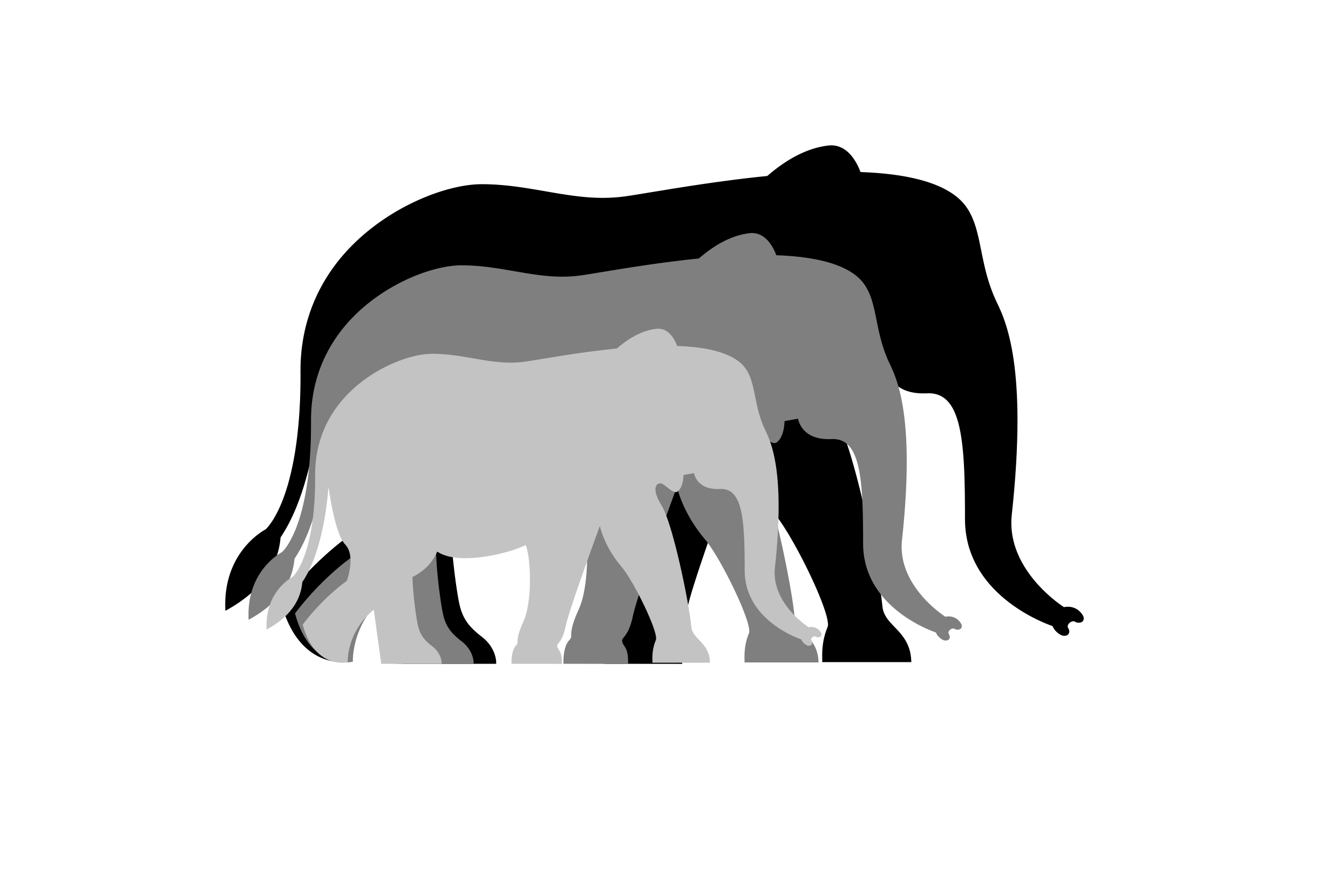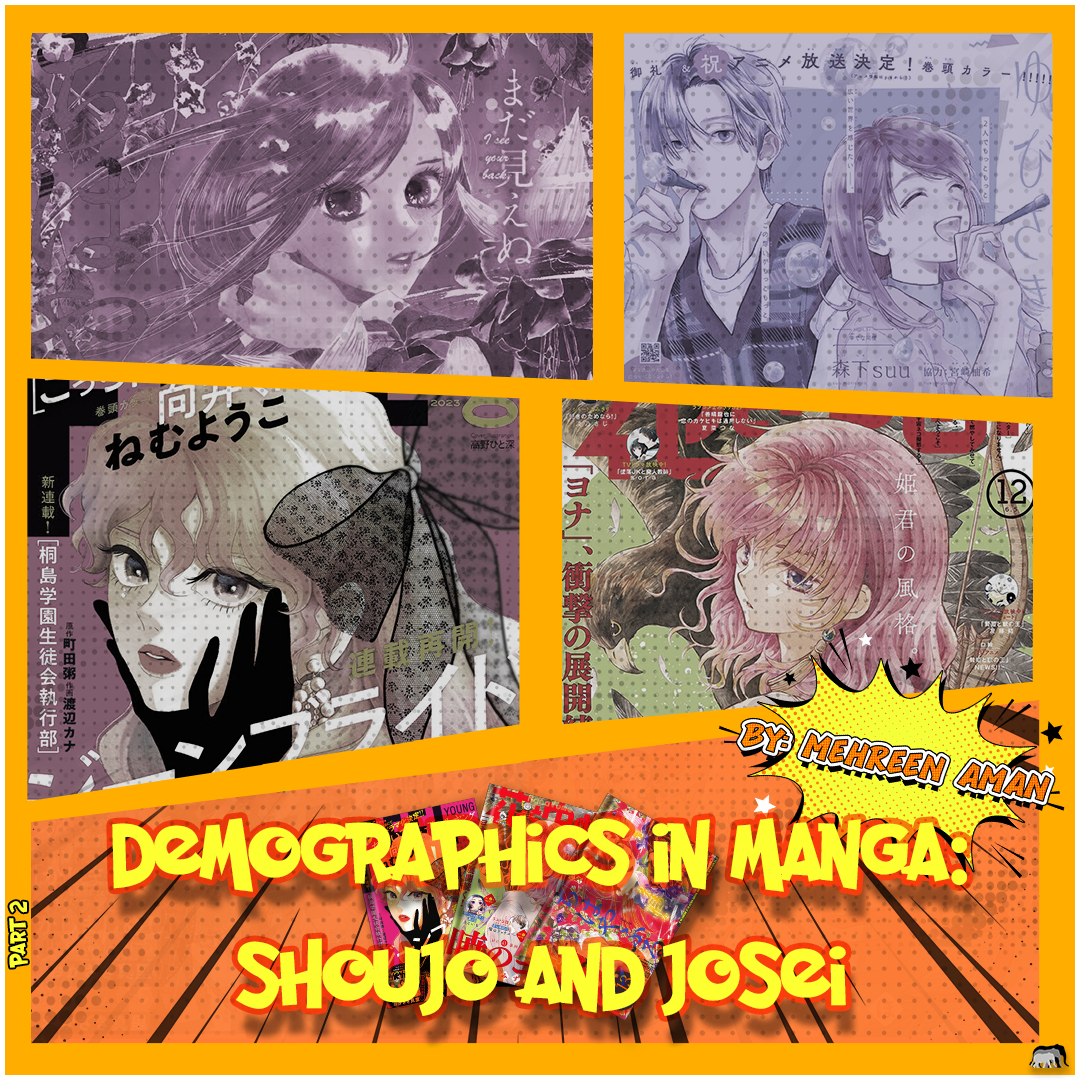Without getting derailed this time, the first demographic I will be discussing fairly extensively in this part is shoujo. The word ‘shoujo’ itself translates to ‘young girl’ and is a demographic that targets young girls and women from approximately around the ages of 12–25. Commonly associated traits with shoujo manga are: use of the female-gaze, introspective dialogues, focus on emotions/emotional storytelling (even within plot and action focused stories), inner character conflicts and portrayal of complex relationships (which can be romantic, platonic, familial etc.). When it comes to shoujo magazines, each magazine has its own identity related to the series and genres it publishes and the age range it targets. For example, the magazine Ribon has a target audience of young girls (mostly pre-teens and young teens) and hence usually tend to be lighter in tone and content with the typical shoujo art style i.e. big shiny detailed eyes and plenty of sparkles. Another magazine, Hana to Yume, is known for its range of genres and is probably the most iconic shoujo magazine in the present day (popular series from this magazine contain Yona of the Dawn and Fruits Basket). Lala is focused more on slice-of-life series and comedy, however it still contains a vast range of genres and stories. Some other shoujo magazines include Princess, Dessert, Margaret, Betsufure, Cookie, Cheese and Ciao. One of the most defining factors of shoujo is its art and panelling: mangaka will make use of elements such as atmospheric bubbles, sparkles, large eyes to put emphasis on emotions, gradual movement of hands to create an effect of tenderness and anticipation, prolonged eye contact between two characters and panels of a character’s thoughts and inner dialogue with themselves.
Many popular currently running shoujo manga are made available to an international audience via fan translations and scanlation groups since oftentimes even the best selling shoujo manga in Japan will not get licensed in English. Whether or not a publisher picks up a manga depends on many factors, including how many volumes in total the manga has. If the volume count is too big and it is a heavy investment, publishers are less likely to licence the manga and these chances are further slimmed if the manga in question is not “trendy” enough or has no major demand from a western audience. Since many shoujo manga, especially the non-highschool romance ones, are practically unknown to people outside Japan (because of either a lack of translations or simply going under the radar), people default to assuming that there is a lack of variety in shoujo. This incorrect perception also comes from the fact that most popular and accessible shoujo manga in the west/outside Japan are highschool or college romances, and with TikTok further popularising these series, the idea that shoujo equals only romance is normalised even more.
However, shoujo has its issues as well. Many people think that all or most shoujo are age-gap series with adult/minor relationships and use this as a way to discredit the entire demographic. While shoujo does have many of these (as does all forms of media, in my opinion it is not exclusively a problem of shoujo manga, rather a problem of stories in general where girls are conditioned into romanticising older men because of their “maturity”), most popular shoujo manga nowadays focus on romance between two people of the same age or in the same age range. It is also important to note that this issue exists in other demographics as well (which doesn’t excuse anything, but it is essential knowledge to have that these issues prevail in manga and media in general – they don’t only exist in media made for women and these misconceptions are made to look down on people who enjoy this demographic). However, in some manga that do feature these relationships, they’re written as cautionary tales and not as fantasies (see Nana, a realistic human drama shoujo where Nana Komatsu, the protagonist, has an affair with a 29-year old married man while she was in her third year of highschool and how it affects her life decisions even into her adult life – her downright awful experiences with men and romance leading to complex inner conflicts with herself).
The last demographic I will be discussing is josei. The word ‘josei’ itself literally translates to ‘woman/female’ and is a demographic that targets adult women from the ages of 18–40 and above. Compared to other manga demographics, this one emerged relatively recently in the 1980s. The term ‘josei’ itself is not used commonly in Japan when it comes to manga, but it is a terminology used in western and international spaces when discussing manga that are aimed at women but aren’t shoujo. The distinction between shoujo and josei is often hard to make without knowledge of magazines, as narrative and stylistic choices in these manga often overlap since they are primarily aimed at women and have intersecting traits. Typically, josei manga tend to have very emotional, dramatic and/or situational plotlines that may contain heavy topics and narratives which require some degree of maturity to fully grasp the weight of. Complex interpersonal relationships, heavy realism, daily lives of people and women in particular, and melodramatic stories are commonly seen in josei manga. Some josei magazines are: Be-Love (Chihayafuru, Nina the Starry Bride, Something’s Wrong With Us), Young You (Honey and Clover, Papa Told Me), Comic Gene (Love of Kill), Comic ZERO-SUM (Karneval, Bokura no Kiseki, Haru’s Curse), Monthly Flowers (7 Seeds, Don’t Call It Mystery, Sakamichi no Apollon, Kaze Hikaru), Cocohana (Blank Canvas: My So-Called Artist’s Journey), Feel Young (Helter Skelter, Ikoku Nikki, &).
Now I will be listing some renowned shoujo and josei mangaka (including classic and influential authors, highly famous ones and those with a skyrocketing popularity nowadays) with a few of their most notable works in the following parentheses. I hope that this helps in enhancing your knowledge about these authors, especially for the ones listed here who are lesser known than others. Buckle up, this will be long, and without further ado: Naoko Takeuchi (Sailor Moon), Ai Yazawa (Nana, Paradise Kiss), Natsuki Takaya (Fruits Basket), Yumi Tamura (Basara, 7 Seeds, Don’t Call it Mystery), Moto Hagio (The Poe Clan), Riyoko Ikeda (The Rose of Versailles), Fuyumi Soryo (Mars), Karuho Shiina (Kimi ni Todoke), Arina Tanemura (Full Moon wo Sagashite, Phantom Thief Jeanne), CLAMP (Cardcaptor Sakura, Tokyo Babylon), Mizuho Kusanagi (Yona of the Dawn), Yuki Suetsugu (Chihayafuru), Suu Morishita (A Sign of Affection), Megumi Morino (A Condition Called Love, Wake Up Sleeping Beauty), Tomoko Ninomiya (Nodame Cantabile), Chica Umino (Honey and Clover), Haruko Kumota (Showa Genroku Rakugo Shinju), Kyoko Okazaki (Helter Skelter, River’s Edge), Mari Okazaki (&, Suppli), Tomoko Yamashita (Ikoku Nikki), Kyouko Ariyoshi (Swan), Yuu Watase (Fushigi Yuugi), Aya Kanno (Otomen, Requiem of the Rose King), Nanae Haruno (Papa Told Me), Bisco Hatori (Ouran High School Host Club), Fumi Yoshinaga (Ooku: The Inner Chambers), Mika Yamamori (In The Clear Moonlit Dusk, Daytime Shooting Star), Julietta Suzuki (Kamisama Kiss), Yoko Kamio (Boys Over Flowers, Cat Street), Yoshiki Nakamura (Skip Beat!), Oreco Tachibana (Firefly Wedding, Promise Cinderella), Moyoco Anno (Sugar Sugar Rune), Akiko Higashimura (Princess Jellyfish).
A disclaimer: the above list is not necessarily a list of my personal favourite manga as it is purely meant to be for an educational purpose; I myself have not read many of these series.
If you scrolled to the end of this article to check exactly how long this monstrosity is… well, I can’t blame you (we had to divide this into 2 parts because I’m insatiable and will take any opportunity to infodump about things I’m passionate about, oopsie). But if this topic intrigued you and you read all (or even some) of it, I hope your main takeaway from this article is that it is unreasonable to think of one demographic as any lesser than another simply because of the (unintentional or intentional) prejudices you may have. Because we belong to this age of social media that consists of an overwhelming amount of media in general, it is easy to get influenced by your peers or the internet into assuming that certain baseless assumptions are truths. Manga, just like any other form of art, is subjective and we all perceive these stories and genres in different ways from each other depending on our personal mindsets and preferences. Making sweeping statements and acting in unsightly manners to people who may enjoy different things than you is a… tasteless thing to do. Ending this article with a generic message, I’ll just say: enjoy what you enjoy, and let others enjoy what they enjoy (and also venture outside your comfort zone sometimes because you may not know which great stories you’re missing out on!)
Resources and references:
- What is shoujo manga? https://www.youtube.com/watch?v=169rKJBBc98&t=186s
- What is josei manga? https://www.youtube.com/watch?v=qPuggKHZ-G8
- Shoujo romance and the female gaze (great resources also available in the description of this video): https://www.youtube.com/watch?v=68RLfzE3dBI
- To learn more about the history of shoujo manga, you may research on the Year 24 Group (a group of female mangaka who heavily influenced shoujo and are said to have brought about the ‘golden age’ of shoujo manga)
By Mehreen Aman
Writer (Team 2023-2024)
Note: the views expressed in the article solely belong to the writer and do not reflect TLC.

